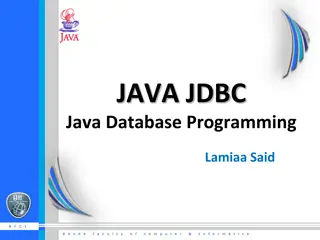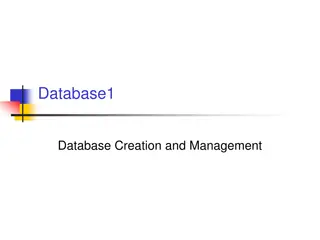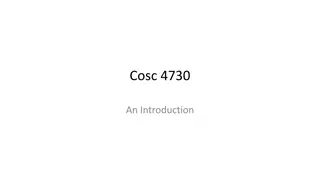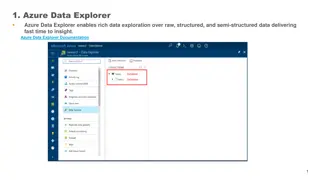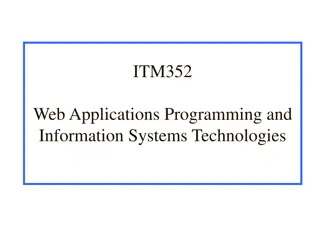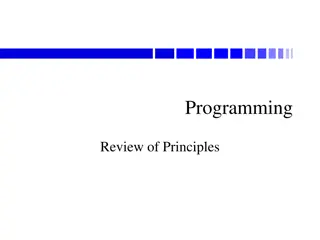Database Implementation Issues in Programming Studio
Key topics covered in the slides include database implementation issues, storing data efficiently, and strategies for handling variable length fields in tuple storage. The presentation delves into specialized algorithms for database efficiency and reliability, terminology related to database implementation, and considerations for storing data like tuples and records. Various challenges and compromises in managing variable length fields in storage systems are also discussed.
Download Presentation

Please find below an Image/Link to download the presentation.
The content on the website is provided AS IS for your information and personal use only. It may not be sold, licensed, or shared on other websites without obtaining consent from the author.If you encounter any issues during the download, it is possible that the publisher has removed the file from their server.
You are allowed to download the files provided on this website for personal or commercial use, subject to the condition that they are used lawfully. All files are the property of their respective owners.
The content on the website is provided AS IS for your information and personal use only. It may not be sold, licensed, or shared on other websites without obtaining consent from the author.
E N D
Presentation Transcript
DATABASE IMPLEMENTATION ISSUES CSCE 315 PROGRAMMING STUDIO, SPRING 2019 ROBERT LIGHTFOOT Slides adapted from those used by Jennifer Welch and John Keyser
DATABASE IMPLEMENTATION Typically, we assume databases are very large, used by many people, etc. So, specialized algorithms are usually used for databases Efficiency Reliability
STORING DATA Other terminology for implementation Relation is a table Tuple is a record Attribute is a field
STORING A RECORD (TUPLE) Often can assume all the fields are fixed (maximum) length. For efficiency, usually concatenate all fields in each tuple. Variable length: store max length possible, plus one bit for termination Store the offsets for concatenation in a schema
EXAMPLE: TUPLE STORAGE Senator Name variable character (100 + 1 bytes) State fixed character (2 bytes) YearsInSenate integer (1 byte) Party variable character (11 + 1 bytes) 116 0 101 103 104
MORE ON TUPLES/RECORDS So, schema would store: Name: 0 State: 101 YearsInSenate: 103 Party: 104 Note that HW/efficiency considerations might give minimum sizes for each field e.g. multiple of 4 or 8 bytes
VARIABLE LENGTH FIELDS Storing max size may be problematic Usually nowhere close waste space Could make record too large for a unit of storage (i.e., disk block) Storing pointers may be problematic Record is not known size, thus variable length records Not much locality in memory Extra storage for pointer Dynamic memory allocation is slow
VARIABLE LENGTH FIELDS Compromise: local pointers Store fixed-length records, followed by variable-length Variable data still kept locally Header stores info about variable fields Pointer to start of each Not great if data in variable field will change
RECORD HEADERS Might want to store additional key information in header of each record Schema information (or pointer to schema) Record size (if variable length) Timestamp of last modification
RECORD HEADERS AND BLOCKS Records grouped into blocks Correspond with a unit of disk/storage Header information with record positions Also might list which relation it is part of. Concatenate records Header Record 1 Record 2 Record n
ADDRESSES Addresses of (pointers to) data often represented Two types of address Location in database (on disk) Location in memory Translation table usually kept to map items currently in virtual memory to the overall database. Pointer swizzling: updating pointers to refer to disk vs. memory locations
RECORDS AND BLOCKS Sometimes want records to span blocks Generally try to keep related records in the same block, but not always possible Record too large for one block Too much wasted space Split parts are called fragments Header information of record Is it a fragment Store pointers to previous/next fragments
ADDING, DELETING, MODIFYING RECORDS Insertion If order doesn t matter, just find a block with enough free space Later come back to storing tables If want to keep in order: If room in block, just do insertion sort If need new block, go to overflow block Might rearrange records between blocks Other variations
ADDING, DELETING, MODIFYING RECORDS Deletion If want to keep space, may need to shift records around in block to fill gap created Can use tombstone to mark deleted records Modifying For fixed-length, straightforward For variable-length, like adding (if length increases) or deleting (if length decreases)
KEEPING TRACK OF TABLES We have a bunch of records stored (somehow). We need to query them (SELECT * FROM table WHERE condition) Scanning every block/record is far too slow Could store each table in a subset of blocks Saves time, but still slow Use an index
INDEX A general term applies to other settings (e.g., index of a file, index of a dictionary, index of search engine) It is a separate file describing the main data file Describe here means giving random access to the data file by some search keys Example: A B C Apple Apricot Ball Banana Blazer Cannot Cat Code Coil . Index file Data file
INDEX IN DATABASE TERMINOLOGY Special data structures to find all records that satisfy some condition Possible indexes Simple index on sorted data Secondary index on unsorted file Trees (B-trees) Hash Tables
SORTED FILES Sort records of the relation according to field (attribute) of interest. Attribute of interest is search key Might not be a true key Index stores (K,a) values K = search key a = address of record with K
DENSE INDEX One index entry per record Useful if records are huge, and index can be small enough to fit in memory Can search efficiently and then examine/retrieve single record only 1 5 7 7 10 12 18 18 18 27 30 35 43 44 65 73 1 5 7 7 10 12 18 18 18 27 30 35 43 44 65 73
SPARSE INDEX (ON SEQUENTIAL FILE) Store an index for only every n records Use that to find the one before, then search sequentially. 1 7 12 27 44 1 5 7 7 10 12 18 18 18 27 30 35 43 44 65 73
MULTIPLE INDICES Indices in hierarchy B-trees are an example 1 27 1 7 12 27 44 1 5 7 7 10 12 18 18 18 27 30 35 43 44 65 73
DUPLICATE KEYS Can cause issues, in both dense and sparse indexes, need to account for 1 7 12 27 44 1 5 7 7 10 12 18 18 18 27 30 35 43 44 65 73
WHAT IF NOT SORTED? Can be the case when we want two or more indices on the same data e.g. Senator.name, Senator.party Must be dense (sparse would make no sense) Can sort the index by the search key This second level index can be sparse
EXAMPLE SECONDARY INDEX 1 27 1 7 12 27 44 1 5 7 7 10 12 18 18 18 27 30 35 43 44 65 73 5 35 18 43 12 44 73 1 65 10 7 18 30 27 7 18
BUCKETS If there are lots of repeated keys, can use buckets Buckets are in between the secondary index and the data file One entry in index per key points to bucket file Bucket file lists all records with that key
EXAMPLE BUCKETS 1 7 12 27 44 1 5 7 10 12 18 27 30 35 43 44 65 73 7 18 18
PUTTING IT ALL TOGETHER To handle variable length records (e.g. VARCHAR(x)), we now have a header for every record If everything were fixed length and we did not care about wasted space, only per-table header would suffice To deal with long disk latency, group as many records in a disk block as possible The rest of the block is empty We need a block header to keep track header Record 3 Record 2 Record 1 A disk block containing records from a table
PUTTING IT ALL TOGETHER (CONTD.) header Record 3 Record 2 Record 1 Insert/Delete/Update operations put this design into test Delete is easier, just mark as deleted Insert/Update might require a lot of move-to-right operations for making room for new/increased data But empty spaces in most blocks, the move-to-right operation does not propagate too much Usually an empty spot is found in the current or surrounding blocks If no surrounding blocks found, overflow blocks can be used Thus, insert/update operations does not undo sorted files
PUTTING IT ALL TOGETHER - INDICES Index is a separate file along with the data file Often small enough to fit in the RAM The main purpose of indices is to avoid scanning all disk blocks Each index entry contains a key and a pointer to the record containing the key Index often resides in the RAM, while the record in the disk Two types of indices: Dense Index (applies to sorted or unsorted files) Sparse (only for sorted files)
STORAGE CONSIDERATIONS Memory Hierarchy Cache Main Memory Secondary storage (disk) Tertiary storage (e.g. tape) Smaller amounts but faster access Need to organize information to minimize cache misses
STORAGE CONSIDERATIONS: MAKING THINGS EFFICIENT Placing records together in blocks for group fetch Prefetching Prediction algorithm Parallelism/Striping placing across multiple disks to read/write faster Example: RAID Mirroring double the reliability
STORAGE CONSIDERATIONS MAKING IT RELIABLE Checksums Mirroring disks Parity bits RAID levels Mostly, out of the scope of this course
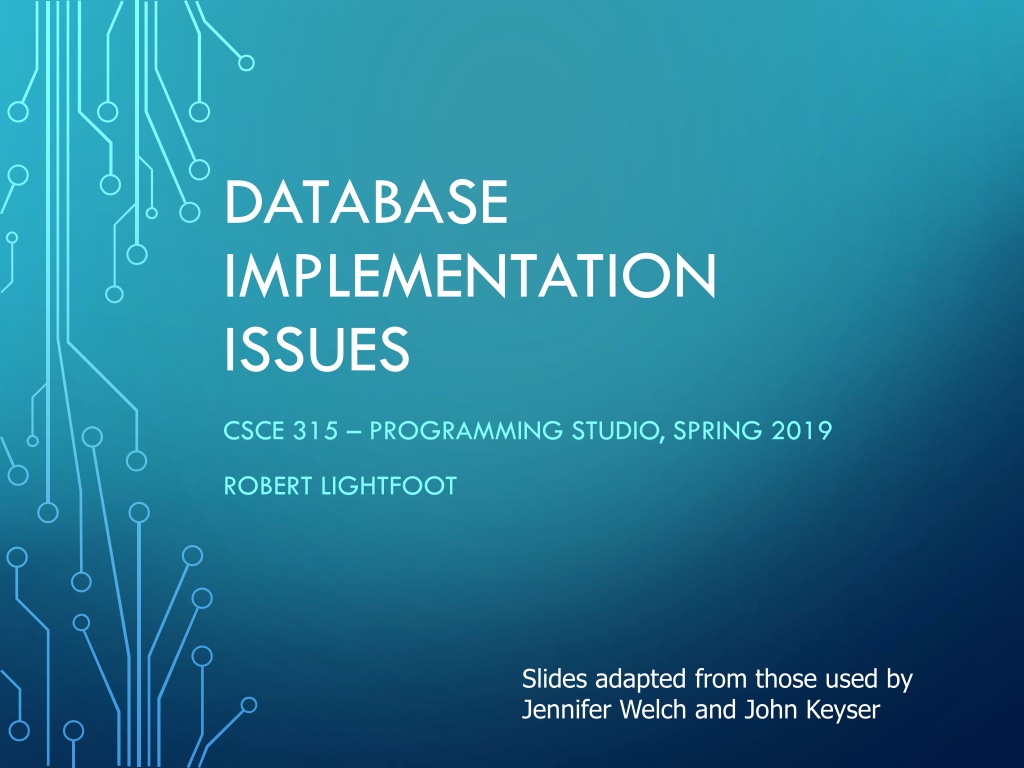
 undefined
undefined











